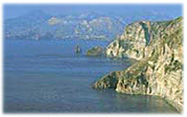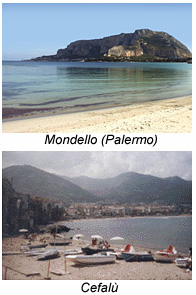Sicily's Eclectic Coast - Coasts of Sicily - Sicily Coastlines - Sicilian Shore (original) (raw)
Home Page Site Search Sights & Activities Localities • Places Good Travel Faqs Sicily's Top 12 Hotels • Planning Maps of Sicily Weather • Climate Nature • History • People Food • Wine • Dining Arts • Literature • Culture Monthly Magazine Sicilian Identity Sicily Links Contact • Follow
Sicily's Eclectic Coasts
From rocky cliffs to sandy shores and mysterious marshes
Related pages: Scenic Sicily • The Mountains • Flora and Fauna • Nature Reserves • Beaches
 It is inescapable. Ubiquitous. And there's no single word to describe it. In Sicily you're never very far from the coast, even when you're in themountains. It's true. From central-Sicilian cities like Enna and Caltanissetta, traveling northward or southward, you're not more than two hours from the coast. If nothing else, they remind you that you're on an island. But while finding the right road to take through the Nebrodior the Madonie mountains isn't always a simple matter, following Sicily's coastline usually isn't too difficult. In fact, some of the more important coastal roads are major motorways (autostrade) boasting dramatic vistas from high vantage points along the edge of steep mountains and cliffs: the A-20 along the Tyrrhenian Sea between Messina and Termini Imerese, the A-18 along the Ionian Sea between Messina and Catania. Others, like the SS-118 state road (strada statale) run lazily along the gentle southern shore kissed by hills and plains from Marsalato Gela. The coasts of Sicily's small islandsare equally varied, ranging from spectacular promontories to inviting beaches. Whatever kind of coastline appeals to you is most probably here in Sicily.
It is inescapable. Ubiquitous. And there's no single word to describe it. In Sicily you're never very far from the coast, even when you're in themountains. It's true. From central-Sicilian cities like Enna and Caltanissetta, traveling northward or southward, you're not more than two hours from the coast. If nothing else, they remind you that you're on an island. But while finding the right road to take through the Nebrodior the Madonie mountains isn't always a simple matter, following Sicily's coastline usually isn't too difficult. In fact, some of the more important coastal roads are major motorways (autostrade) boasting dramatic vistas from high vantage points along the edge of steep mountains and cliffs: the A-20 along the Tyrrhenian Sea between Messina and Termini Imerese, the A-18 along the Ionian Sea between Messina and Catania. Others, like the SS-118 state road (strada statale) run lazily along the gentle southern shore kissed by hills and plains from Marsalato Gela. The coasts of Sicily's small islandsare equally varied, ranging from spectacular promontories to inviting beaches. Whatever kind of coastline appeals to you is most probably here in Sicily.
However you arrive in Sicily, the coast is the first thing you encounter. It so happens that the principal airports are not far from the shore, and neither are the major cities. This is not an accident of Sicilian history. We tend not to think about it much today, but it's obvious that from antiquity through the Middle Ages the peoples who conquered Sicily all navigated their way here. Some of them, like the Normans, were unaccustomed to sea travel and had to re-acquaint themselves with it to get across the Strait of Messina.
Unless you decide to literally drive around Sicily, following a thousand kilometers of coastline, your travels will probably take you to one or more regions of Sicily, and it's generally better to think of the coast in that kind of context.
If you venture much beyond the larger cities, you'll discover that there are essentially two kinds of Sicilians - those who enjoy the mountains and those who enjoy the coastal areas and beaches. Actually, in Sicily it's possible to have both temperaments because here many beaches (like Cefalù's shown) are so near the mountains. Sicily's coasts offer some fascinating features. Capo Bianco, near the archeological site of Eraclea Minoa (and the town of Montallegro) at the mouth of the Platani River west of Agrigento, has a beach in the shadow of white cliffs. The cliff formations at Scala dei Turchi, near Realmonte in the same region, look as if they were haphazardly carved by a giant wielding a huge knife.
 The flatlands of the regions farther west deviate from this geologic pattern. Trapani's coast has salt pans and windmills.
The flatlands of the regions farther west deviate from this geologic pattern. Trapani's coast has salt pans and windmills.
San Vito lo Capo, near Trapaniwest of Palermo, is one of many dramatic capes jutting out into the sea beneath a mountain. Cefalù is another example.
There are a number of coastal islets you can spot just off the shore: Isola delle Femmine near the town of the same name, the Cyclops Islets off Acitrezza north of Catania (along the "Riviera dei Ciclopi"), Isola Bella (connected to the coast in recent times) off Mazzarò below Taormina.
Myth and legend play into the legacy of Sicily's wild coasts. It was when the Cyclops tossed giant stones at a fleeing Odysseus that the islets bearing his name are said to have sprung up along the Ionian coast. And the hero was threatened by Charybdis at the straits. In western Sicily the coasts are dangerous for the tuna who fall prey to hunter-fishermen during the Mattanza, a quasi-ritual practiced since Sicily's Arab period.
The coastal nature reserves are especially enticing. While there are a number of these, rather few are normally open to the public. Lo Zingaro is a rocky coast near Scopellowest of Palermo. The marshes of Vendicari, near Noto, are a paradise for flora and fauna, including rabbits, lizards and birds.
The mouth of the Ciane river, which empties into the Gulf of Syracuse near some salt pans similar to Trapani's (though no longer worked), is a tiny nature reserve where papyrus grows.
With the constant movement of waves and tides - moreso along some stretches of coast than others - Sicily's shores take on a life of their own. There's the occasional castle or tower to remind us of the perils of times past, mostly pirates. Indeed, part of Palermo's coast takes its name, Acque dei Corsari, or "Corsairs' Waters," from the marauders who raided the area into the sixteenth century. They're the reason Charles V ordered the construction of high walls to protect Catania, Messina, Palermo and the other coastal metropoli, and a series of watch towers. It is most often these towers, rather than medieval ones, that one encounters along the coasts; each was within signalling distance of the next one.
In the southeastern part of the island, around Ragusa and Noto, responsibility for protecting the coast was occasionally assumed by the Knights of Malta, who maintained a few small commanderies in the region, Malta itself being a nominal part of the Kingdom of Sicily until 1798. The rocky coasts can be treacherous. King Roger is said to have been shipwrecked at Cefalù, where he decided to erect a cathedral to thank God for saving him, and Saint Paul was shipwrecked on Malta.
In flat areas where there are no beaches you'll encounter the "gold coasts" of lemon and orange orchards. Nowadays these rarely run right down to the water's edge, where there may be seaside cottages - some of which have been built illegally, against regulations intended to protect the coastline.
Whether you view Sicily's coast as a single endless shoreline or a series of smaller coasts, its diversity is something that will never disappoint you.